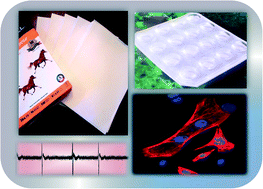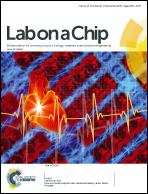Human induced pluripotent stem cell-derived beating cardiac tissues on paper†
Abstract
There is a growing interest in using paper as a biomaterial scaffold for cell-based applications. In this study, we made the first attempt to fabricate a paper-based array for the culture, proliferation, and direct differentiation of human induced pluripotent stem cells (hiPSCs) into functional beating cardiac tissues and create “a beating heart on paper.” This array was simply constructed by binding a cured multi-well polydimethylsiloxane (PDMS) mold with common, commercially available paper substrates. Three types of paper material (print paper, chromatography paper and nitrocellulose membrane) were tested for adhesion, proliferation and differentiation of human-derived iPSCs. We found that hiPSCs grew well on these paper substrates, presenting a three-dimensional (3D)-like morphology with a pluripotent property. The direct differentiation of human iPSCs into functional cardiac tissues on paper was also achieved using our modified differentiation approach. The cardiac tissue retained its functional activities on the coated print paper and chromatography paper with a beating frequency of 40–70 beats per min for up to three months. Interestingly, human iPSCs could be differentiated into retinal pigment epithelium on nitrocellulose membrane under the conditions of cardiac-specific induction, indicating the potential roles of material properties and mechanical cues that are involved in regulating stem cell differentiation. Taken together, these results suggest that different grades of paper could offer great opportunities as bioactive, low-cost, and 3D in vitro platforms for stem cell-based high-throughput drug testing at the tissue/organ level and for tissue engineering applications.


 Please wait while we load your content...
Please wait while we load your content...